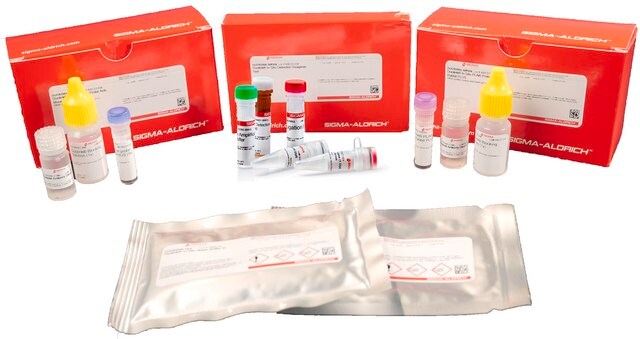DUO94105
Duolink® flowPLA Mouse/Rabbit Starter Kit - Violet
Duolink® PLA kit for Flow Cytometry with Violet Detection and Mouse/Rabbit probes
Synonim(y):
Duolink Starter Kit
About This Item
Polecane produkty
Poziom jakości
metody
flow cytometry: suitable
immunofluorescence: suitable
proximity ligation assay: suitable
fluorescencja
λex 390 nm; λem 476 nm
przydatność
suitable for fluorescence
temp. przechowywania
−20°C
Specyficzność
Use appropriate laser for λex 390 nm excitation
Use appropriate filter for λem 476 nm emission.
Application Note
Primary antibodies are needed. Test your primary antibodies (IgG-class, mono- or polyclonal) in a standard immunofluorescence (IF), immunohistochemistry (IHC), or immunocytochemistry (ICC) assay to determine the optimal fixation, blocking, and titer conditions. Flow validated antibodies are recommended.
Let us do the work for you, learn more about our Custom Service Program to accelerate your Duolink® projects.
View full Duolink® product list
Zastosowanie
Duolink® flowPLA Starter Kits will enable sensitive detection of proteins, protein-protein interactions, and protein modifications within cell populations by flow cytometry. To perform a Duolink® flowPLA experiment, you will need fixed, suspended cells, two primary antibodies that specifically recognize your proteins of interest and the Duolink® flowPLA starter Kit. The flowPLA Starter Kits are available with 3 different fluorophores: Violet, Green, and FarRed. The flowPLA starter Kits contain all the necessary reagents reagents for 100 Duolink® PLA reactions, including a pair of PLA probes (Anti-Rabbit PLUS and Anti-Mouse MINUS) and all the reagents to perform the amplification and detection of bound PLA probes by flow cytometry. Analysis is carried out using standard flow cytometry assay equipment. User must provide a fixed cell suspension, (rabbit and mouse-raised) primary antibodies, and corresponding PLA Probes.
Follow the Duolink® PLA Flow Cytometry Protocol to use this product.
Visit our Duolink® PLA Flow Cytometry page on how to run a Duolink® flow experiment, applications, troubleshooting, and more.
Cechy i korzyści
- Analyze protein protein interactions with flow cytometry readout
- Analyze cell populations with Proximity Ligation Assay
- Increased sensitivity due to rolling circle amplification for low abundant targets
- No overexpression or genetic manipulation required
- Relative quantification possible
- Works with any flow cytometer instrumentation
- Easy to follow flexible protocol
- Publication-ready results
Komponenty
Duolink® In Situ PLA® Probe Anti-Mouse MINUS DUO92004-40TST
Duolink® In Situ PLA® Probe Anti-Rabbit PLUS DUO92002-40TST
Duolink® In Situ Wash Buffer, Brightfield (DUO82047-4L)
See datasheet for more information.
Informacje prawne
PLA is a registered trademark of Sigma-Aldrich Co. LLC
Hasło ostrzegawcze
Danger
Zwroty wskazujące rodzaj zagrożenia
Zwroty wskazujące środki ostrożności
Klasyfikacja zagrożeń
Aquatic Chronic 2 - Resp. Sens. 1 - Skin Sens. 1
Kod klasy składowania
10 - Combustible liquids
Certyfikaty analizy (CoA)
Poszukaj Certyfikaty analizy (CoA), wpisując numer partii/serii produktów. Numery serii i partii można znaleźć na etykiecie produktu po słowach „seria” lub „partia”.
Masz już ten produkt?
Dokumenty związane z niedawno zakupionymi produktami zostały zamieszczone w Bibliotece dokumentów.
Produkty
Traditional flow cytometry has been limited in the ability to detect protein-protein interactions and low abundant proteins events — until now. We have combined Duolink® Proximity Ligation Assay (PLA) with flow cytometry in a convenient kit, making the analysis of protein-protein interactions with flow cytometry readouts a reality.
General tips and tricks for proper experiment execution, aid in identifying potential problems, and provide solutions to ensure a successful Duolink® PLA experiment for flow cytometry.
Dowiedz się, jak działa technologia Proximity Ligation Assay i jak zestaw kontrolny interakcji białko-białko może potwierdzić wykrywanie in situ dimeryzacji EGFR-HER2 indukowanej przez EGF.
Protokoły
Protocol for use of Duolink® PLA reagents for the detection of individual proteins, protein modifications, and protein-protein interactions within cell populations by flow cytometry.
Nasz zespół naukowców ma doświadczenie we wszystkich obszarach badań, w tym w naukach przyrodniczych, materiałoznawstwie, syntezie chemicznej, chromatografii, analityce i wielu innych dziedzinach.
Skontaktuj się z zespołem ds. pomocy technicznej






